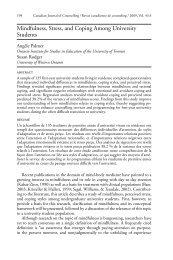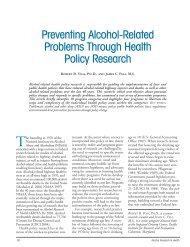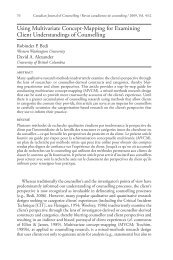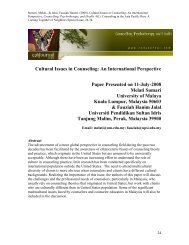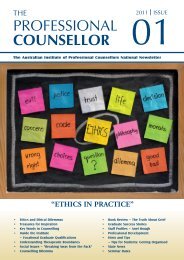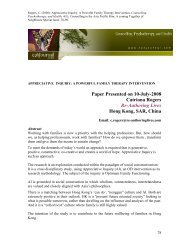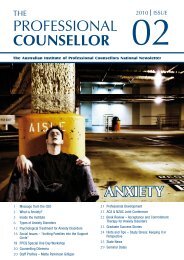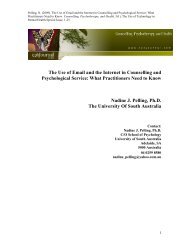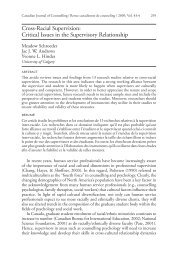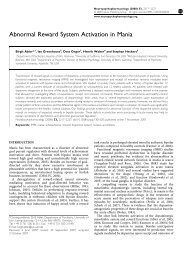PROFESSIONAL COUNSELLOR - Mental Health Academy
PROFESSIONAL COUNSELLOR - Mental Health Academy
PROFESSIONAL COUNSELLOR - Mental Health Academy
- No tags were found...
Create successful ePaper yourself
Turn your PDF publications into a flip-book with our unique Google optimized e-Paper software.
THE <strong>PROFESSIONAL</strong> <strong>COUNSELLOR</strong>03 2007particularly, each other’s. Of therapeutic interest iswhether clients, in taking up a therapist’s curiositiesand intentions, can talk relationally acceptableunderstandings and ways of moving forward togetherinto being.Practice 5: Enabling sustained use of acceptableunderstandings and communications beyond thetherapeutic context.It is one thing to talk new and re-deliberatedunderstandings and ways of going on into being in thetherapeutic context, but for them to be used and ofvalue beyond that context is another matter. Needed,to paraphrase Bateson (1980), are “differences thatmake a difference.” This is important given how newunderstandings and ways of moving forward areperformed in therapy, not just talked about (Holzman& Newman, 2004). Clients who successfully try on, orperform, new ways of understanding and talkingtogether within therapy are more likely to continueusing them beyond therapy. Therapists can see part oftheir challenge as joining such new ways ofunderstanding and talking, while inviting more of thenew talk, lest clients slip back into habits ofobjectionable talk. There are other ways therapeuticunderstandings and communications can be promotedbeyond the consulting room, however. Narrativetherapists (White & Epston, 1990) sometimes considersuch changes as akin to anthropology rites of passage,as transformative events to signify and extendtherapeutic developments. They also incorporatedocuments, celebrations, or ritualized performances toextend the conversation (Epston, 1994) by honoringand further crystallizing new understandings andactions beyond therapy.Practice 6: As further inadequate orobjectionable patterns of language use areidentified these too are attended to, evaluated,and reconstructed to enable further redeliberations.As a preference-focused endeavor, constructionistapproaches to family therapy are mindful of howclients can become ensnared in their narratives(Shotter, 1993), or in particular understandings andways of communicating that limit their possibilities tomove on. Sometimes it takes a well-honed question tohelp clients reflect and re-deliberate on taken-forgrantedmeanings and ways of talking to becomeaware of what is objectionable so a deliberate choicecan be made to change. Other times, clients mightwant their objections acknowledged before movingon. Regardless, therapy offers a process wherebyclients can be invited to reflect on the adequacy oftheir meanings and ways of talking.Where these have been objectionable orinadequate, therapy can navigate and negotiate alinguistic course to more preferred meanings and waysof talking that enable family members to coordinatetheir efforts in moving forward together. However,attempts to alter understandings or ways of talkingbear fruit only when they are deemed acceptable andare taken up by family members. We would now liketo relate how we see these orienting ideas translatingto actual practice.Constructionist Family Therapy in ActionThe Consultation Begins: Understanding theFamily as a System of Communicative Interaction.Karl Tomm, an experienced Caucasian therapist,recently met with a Caucasian family as part of areflecting team consultation held at the Calgary FamilyTherapy Program Centre which he directs. The “A”s(we have altered names to protect the family’s privacy)had been seeing one of the Centre’s therapists overthe course of the previous year. The parents, Don (54)and Lori (52), initially sought counseling because theirchildren, Bert (17) and Dora (14), had been fighting. Aweek prior to the consultation the mother anddaughter had fought physically so Lori elected to leavethe family home. This session was the first opportunityto reunite as a family since Lori left.Karl began by checking with each family memberabout past experiences in therapy, and asked whateach member hoped to gain from the consultation.Early on, Lori shared her concern about addressing“core issues,” prompting clarifying questions from Karl,to which Lori spoke of “insecurities” and “deception”in her relationship with Don. Lori’s understandingswere met with reactions that indicated the family wasat an objectionable juncture: Don became visiblyrestless and withdrew into wary silence.Karl did not see these as Lori’s concerns alone, andso he requested a “thicker” description, broadeningthe discussion to how “insecurity” and “deception” hadinfluenced the family. Here, he asked circularquestions pertaining to “deception,” questionsassociated with the Milan Family Therapy Team(Selvini-Palazzoli, Boscolo, Cecchin, & Prata, 1980),such as “What is your understanding of Don’s(deceptive) behavior?” Such questions invited adifferent way of conversing as a family, and Lori wasasked to disclose understandings “deception” had forher, but in ways to which other family members couldhear and add. Such questions invited re-deliberationson how the “A”s discussed and understood“deception.”This became even more evident as Karl directlyinvolved Don in the discussion, asking him for hismeanings for “deception” and the influence“deception” held in his life. The children later joinedthe discussion, collectively turning “deception” from atopic that entailed closed and “deceptive”communications into a topic openly and franklydiscussed in the consultation. Possible new, and moreacceptable, ways of moving forward together werebeing understood and performed in the consultation.5



